#festival do salvador
Explore tagged Tumblr posts
Text

happy hispanic heritage month 🎉 ft my ocs who were designed with the intent of being hispanic
#i’m salvadorian so i drew them in some festival clothing from el salvador!!! or at least what i hope is the right clothing from there!!#disclaimer i am not very connected to my own culture at all but i tried to do some research and i asked my dad abt which region he’s from#so i tried to pick the clothing from that region#i’m worried i’m committing the grave sin of cultural appropriation even tho it’s my own culture i just have a lot of worries#my art#hispanic heritage month#btw ocs are miss producer / human version of my inkling eun / angel rhea / pokemon trainer ivy#sorry this is like . Not at all my usual stuff i just wanted to do a little thing for this year! because i don’t appreciate my own culture#and background enough . i don’t even know spanish :’-)#but i want to learn more abt it i want to appreciate more
17 notes
·
View notes
Text

Mãe Marta stands above her divination instruments, the buzios or cowrie shells. As she tosses them on her table, the position in which they fall indicates a response from the Orishas, which she interprets for the inquirer.
Yalorixá Mãe Marta de Oyá spends much of her time split between satisfying the demands of restless spirits and troubled souls.
As head priestess of the only Candomblé temple in Santo Antônio do Carmo, the historic center of Salvador da Bahia in northeast Brazil, the 45-year-old has her work cut out for her.
When not preparing feasts and festivals in the Candomblé tradition, she is catering to the needs of adherents to the faith who need a little guidance. She also conducts cleansings for those who believe their home could benefit from a better spiritual balance.
#Yalorixá Mãe Marta de Oyá#head priestess#Candomblé#Temple#Santo Antônio do Carmo#Salvador#Bahia#Brazil#Tradition#Culture#Spirituality#History#Buzios#Cowrie Shells#Orisha
124 notes
·
View notes
Text
Olodum is a bloco-afro from Salvador's carnival, in Bahia, Brazil. It was founded by the percussionist Neguinho do Samba.
Olodum develops activism to combat social discrimination, boost the self-esteem and pride of Afro-Brazilians, and defend and fight to secure civil and human rights for marginalized people in Bahia and Brazil. It developed a social project called Escola Olodum (Olodum School).

Annually, since 1980, in Salvador's Bahian Carnival, Olodum
discusses topics related to the importance of African culture in the construction of society, as in the 2014 carnival theme, "Ashanti - The Golden Throne and the Queen Yaa Asantewaa." The theme song is chosen in a songwriter competition called FEMADUM (in English, Olodum's Music and Arts Festival).

#african#afrakan#kemetic dreams#africans#brownskin#brown skin#afrakans#african culture#afrakan spirituality#michael jackson#Nguni#african music#epic video
102 notes
·
View notes
Note
xexyyy, vc pode por favor fazer headcanon dos meninos visitando o brasil pela primeira vez? onde eles iriam, o que cometiam, o que eles mais gostariam daqui? uma parada bem fofinha e bem brasileira. obrigadaaa!
wn: demorou mais chegou! acho que me empolguei demais kkkk espero que goste <3
meninos do cast x primeira vez no brasil.
fem!reader headcanon
tw: menção de uso de drogas ilícitas!!!!
enzo:
apesar de ter ficado tentado por são paulo, preferiu visitar minas gerais. cidades históricas, inhotim, muito museu e espaço cultural. além do povo receptivo e gentil.
ia tentar te arrastar para todos os dias de um festival de cinema independente que encontrou na internet.
e nada de praia, que fique claro. ia escolher uma época com o clima mais frio, se possível.
mas não negaria também visitar salvador e sua cultura exuberante. pretende ir ao pelourinho algum dia, sim.
é encantado pela culinária contemporânea brasileira - então iria em grandes restaurantes, assinados por chefs brasileiros de renome. mas claro, não perderia a oportunidade de experimentar toda e qualquer comida de barraquinha que lhe parecesse interessante.
agustin:
é praia atrás de praia, papai. viu um itinerário na internet que passa por várias praias incríveis do nordeste em uma rota só, começando no ceará e terminando em pipa.
inclusive, a vibe da viagem é essa: roadtrip. pernoite em pousadas pequenas, sem muito luxo.
vai tentar falar com as pessoas em português depois de fazer três lições no duolingo pra pedir desconto. e vai falhar miseravelmente.
você não sabe COMO, mas ele arranjou um contato de maconha. e diz que a brasileira é mais gostosinha que a da argentina, tá?
comida de praia! vai se apaixonar pela farofa, pirão e peixe frito. e pelo picolé pardal depois do almoço.
matías:
é são paulo! sempre foi são paulo! afinal, além de achar a capital interessantíssima, tem um ritmo que combina com o próprio matías.
não só isso, mas ele gosta dessa coisa da cidade grande e acha são paulo muito parecido com buenos aires, de alguma forma.
vai querer explorar o restante do estado também, tá?
gosta sim de visitar os museus (vai adorar o museu da língua portuguesa, por exemplo), mas a vibe dele é andar pelas ruas e ir acompanhando o movimento. vai adorar o circuito gastronômico de baixo do copan.
comida de rua! finger food de barzinho. vai adorar os salgados do estadão.
fran:
fran sinceramente não consegue decidir pra onde quer mais ir - então resolve ir, aos poucos, por centros mais afastados das capitais.
tipo campos do jordão ou jalapão, por exemplo. ele dá uma evitada nas praias ou regiões de maior calor porque não gosta muito, mas corre pra cima das áreas verdes.
ele adora a vibe da cidade, adora a vibe do movimento e dos museus contemporâneos, mas a pegada que deixa fran feliz é a natureza e o movimento mais tranquilo.
ele vai pirar nas fotos, nos espaços culturais (mesmo que pequenininhos), nas trilhas, parques, etc.
fran come de tudo e vai querer comer de tudo. dá prioridade aos estabelecimentos mais familiares/pequenos do que a restaurantes grandes e famosos.
kuku:
esteban é turista, adora turistar e não tem a menor vergonha disso. em uma primeira viagem, vai escolher o destino mais turista possível, sim. depois ele vai começar a explorar os demais locais.
ou seja: é rio de janeiro neles.
mas não vai ficar só na capital não, tá? vai fazer daqueles passeios completos com direito a petrópolis e búzios. quer ir de uma ponta a outra, descobrir tudo que ele puder descobrir, do mais badalado ao mais local.
vai comprar um cristo redentorzinho, imã de geladeira do aquário, chaveiro pra distribuir, foto paga no pão de açúcar, calçadão de copacabana, etc etc etc.
fã declarado e de carteirinha da culinária brasileira daquela clássica que a gente vê na tv. vai procurar os restaurantes mais tradicionais e pedir dica de outros locais que possa comer uma boa feijoada, por exemplo.
pipe:
independente do lugar, é importante deixar claro que pipe vai encontrar um estádio de futebol e vai fazer questão de assistir um jogo - com preferência pra alguma rivalidade clássica entre times da cidade.
ele é da praia, assim como o agustin, mas de uma praia mais cidade. iria ser muito feliz visitando alguma capital nordestina litorânea.
numa vibe mais badalada como jericoacoara no ceará (que fica perto de fortaleza pra ele poder assistir um clássico rei, por exemplo).
é da comida típica e vai querer provar de um tudo, mas também é fã de ver as diferenças entre as redes de fast food. sim, ele vai querer provar um bigmac pra ver se o gosto é o mesmo.
apesar da carinha de hétero top, pipe é muito ligado a cultura, viu? então ele vai querer visitar sim todos os museus, centros culturais e cinemas de rua que puder. quanto mais local, mais ele prefere.
#enzo vogrincic x reader#enzo vogrincic#agustin pardella x reader#agustin pardella#matias recalt#matias recalt x reader#fran romero x reader#fran romero#esteban kukuriczka x reader#esteban kukuriczka#pipe otaño x reader#pipe otaño#hc
110 notes
·
View notes
Text
All Of Shuu’s TG Calender Appearances! (In Chronological Order!)
*this was initially just gonna be a twitter thread but I’m posting it here first bc is easier to draft and arrange. :) Wrote the little information cards that are under the pics and will try to image ID them for the text late one.
Under a cut bc there are twenty-four of them! Enjoy! <3
(I believe the image below is from an anime calender? Or something? I’m not sure.)
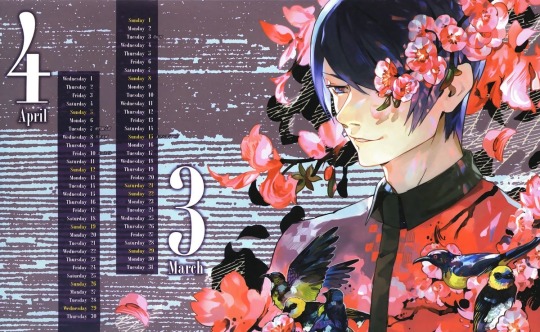
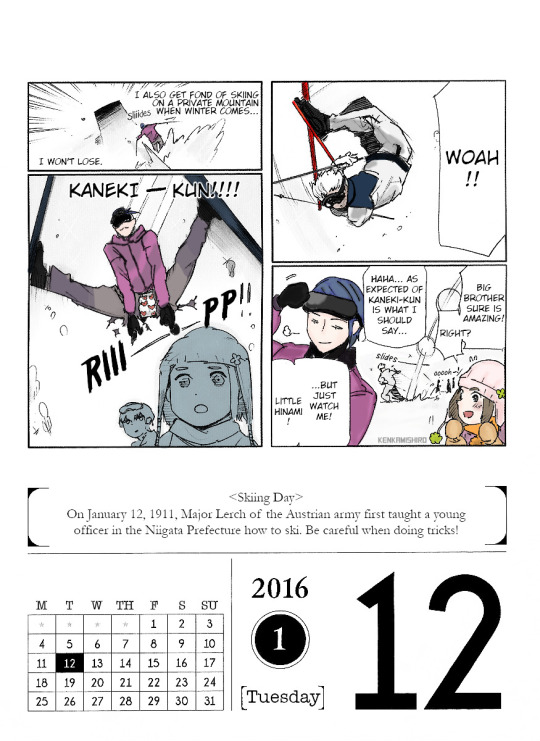
January 12th - Skiiing Day
On January 12, 1911, Major Lerch of the Austrian Army first taught a young officer in the Niigata Prefecture how to ski. Be careful when doing tricks!
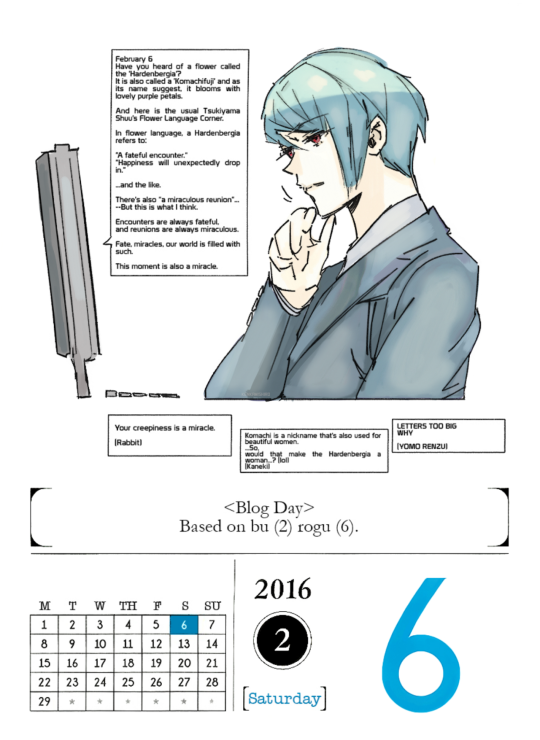
February 6th - Blog Day
Based on bu (2) rogu (6). A blog post from Shuu, it reads: “February 6 Have you heard of a flower called the ‘Hardenbergia’? It is also called a ‘Komachifuji’ and as its name suggests, it blooms with lovely purple petals. And here is the usual Tsukiyama Shuu’s Flower Language Corner. In flower language, a Hardenbergia refers to: “A fateful encounter.” “Happiness will unexpectedly drop in.” …and the like. There’s also “a miraculous miracle”… —But this is what I think. Encounters are always fateful, and reunions are always miraculous. Fate, miracles, our world is filled with such. This moment is also a miracle.” The comments feature Touka being quite rude, Kaneki adding little of importance, and Yomo not understanding technology.
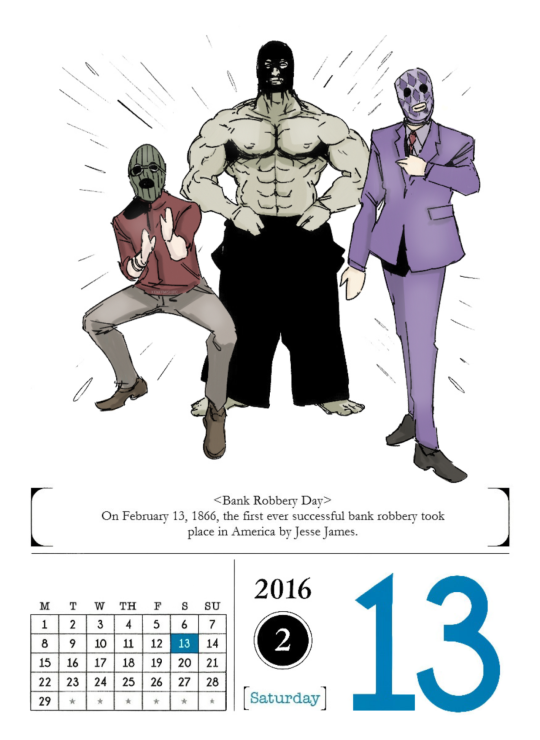
February 13th - Bank Robbery Day
On February 13th, 1866, the first ever successful bank robbery took place in America by Jesse James.
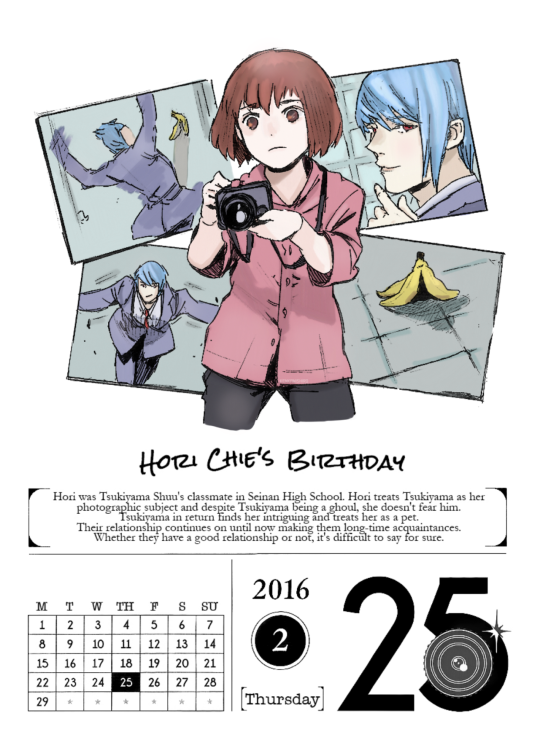
February 25th - Hori Chie’s Birthday
Hori was Tsukiyama Shuu’s classmate in Seinan High School. Hori treats Tsukiyama as her photographic subject and despite Tsukiyama being a ghoul, she doesn’t fear him. Tsukiyama in return finds her intriguing and treats her as a pet. Their relationship continues on until now making them long-time acquaintances. Whether they have a good relationship or not, it’s difficult to say for sure.
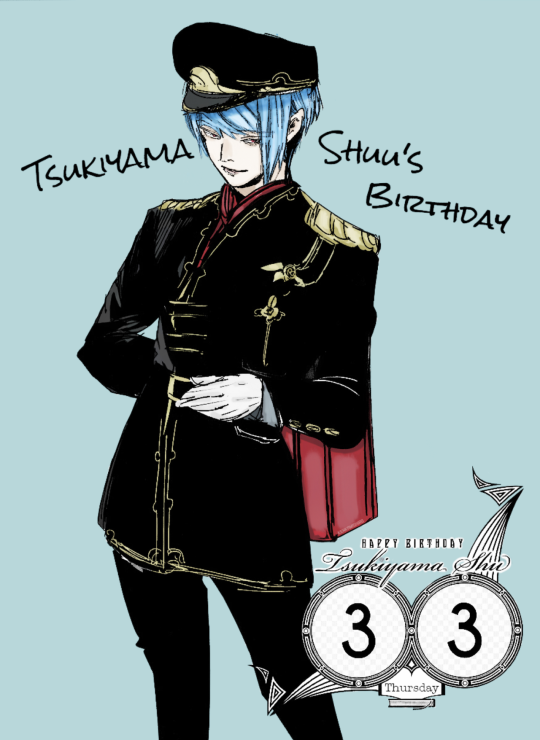
March 3rd - Tsukiyama Shuu’s Birthday. (Obviously.)
Happy Birthday, Tsukiyama Shu.
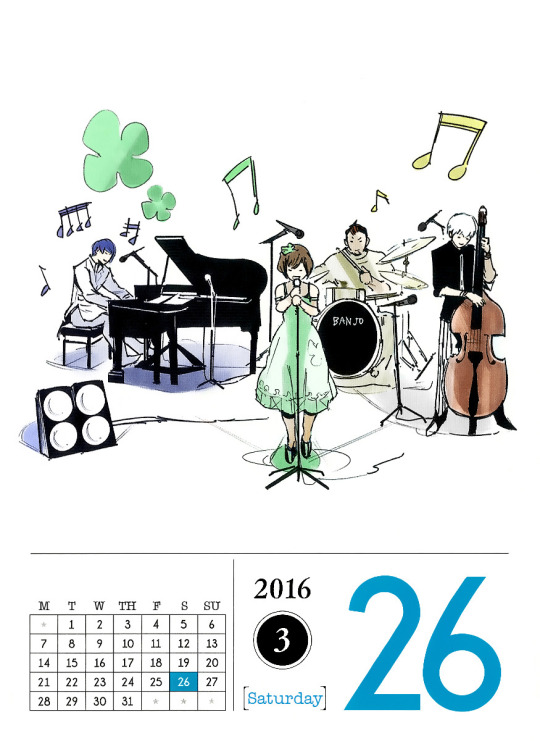
March 26th - Untitled.
No text.
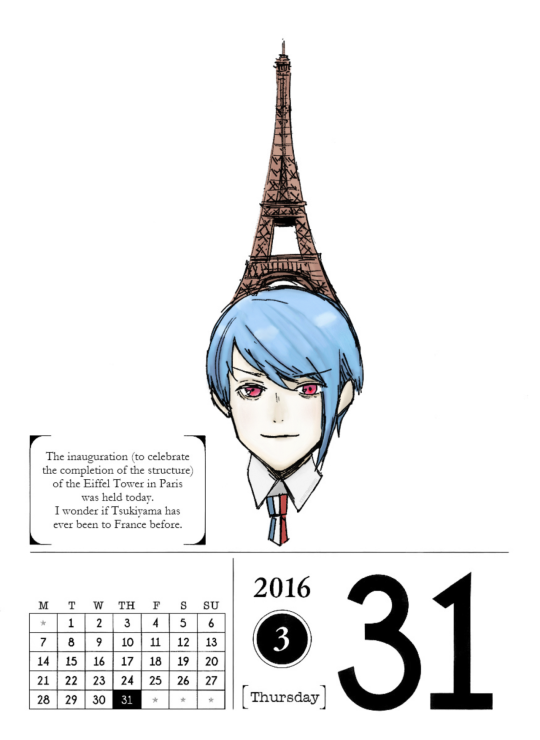
March 31st - Untitled.
The inauguration (to celebrate the completion of the structure) of the Eiffel Tower in Paris was held today. I wonder if Tsukiyama has ever been to France before.
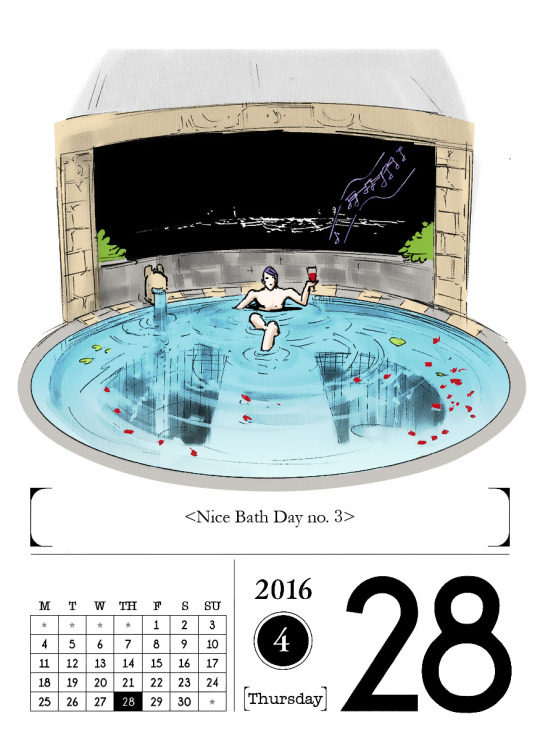
April 28th - Nice Bath Day no. 3
No text.
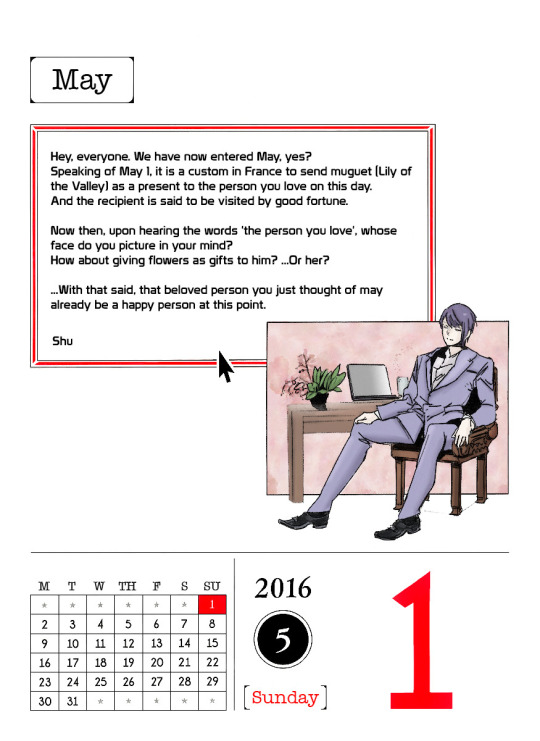
May 1st - Untitled. Shu’s second blog post.
This blog reads as follows: ‘Hey, everyone. We have now entered May, yes? Speaking of May 1, it is a custom in France to send muguet (Lily of the Valley) as a present to the person you love on this day. And the recipient is said to be visited by great fortune.” Now then, upon hearing the words ‘the person you love’, whose face do you picture in your mind? How about giving flowers as gifts to him?…Or her? …With that said, that beloved person you just thought of may already be a happy person at this point. Shu.’
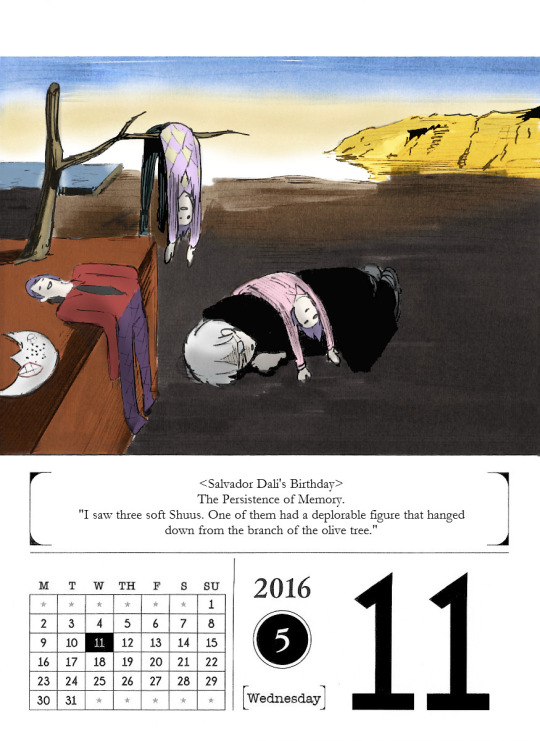
May 11th - Salvador Dali’s Birthday
The Persistence of Memory. “I saw three soft Shuus. One of them had a deplorable figure that hanged down from the branch of the olive tree.”
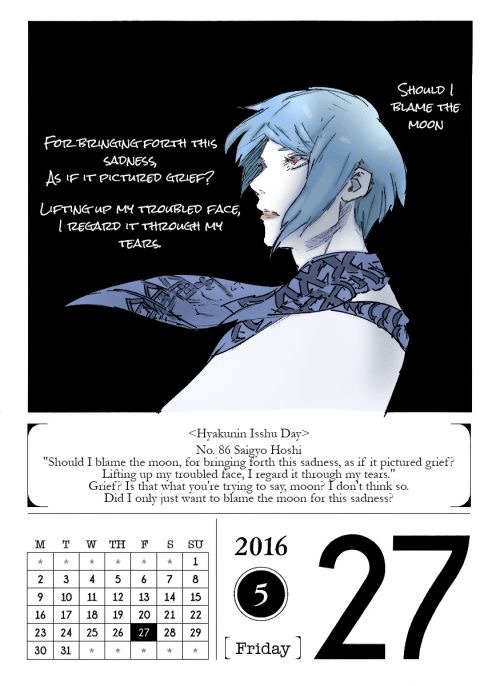
May 27th - Hyakunin Isshu Day
No. 86 Saigo Hoshi “Should I blame the moon, for bringing forth this sadness, as if it pictured grief? Lifting up my troubled face, I regard it through my tears.” Grief? Is that what you’re trying to say, moon? I don’t think so. Did I only just want to blame the moon for this sadness?
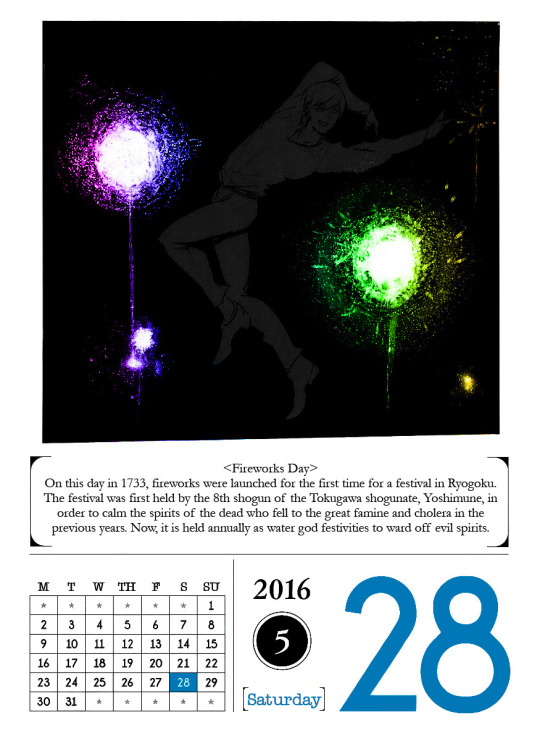
May 28th - Fireworks Day.
On this day in 1733, fireworks were launched for the first time for a festival in Ryogoku. The festival was first held by the 8th shogun of the Tokugawa shogunate, Yoshimune, in order to calm the spirits of the dead who fell to the great famine and cholera in the previous years. Now, it is held annually as water god festivies to ward off evil spirits. (Note: turn up the brightness or stare very hard for a long time. He is there, I promise.)
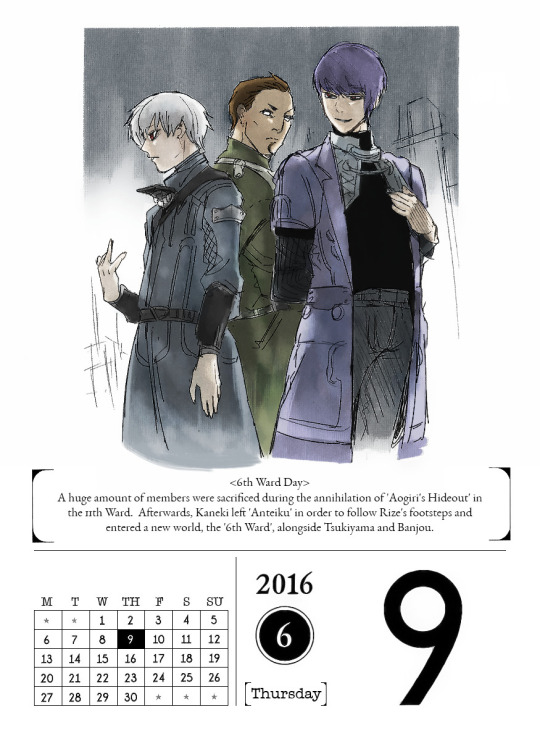
June 9th - 6th Ward Day
A huge amount of members were sacrificed during the annihilation of ‘Aogiri’s Hideout’ in the 11th Ward. Afterwards, Kaneki left ‘Anteiku’ in order to follow Rize’s footsteps and entered a new world, the ‘6th Ward’, alongside Tsukiyama and Banjou.
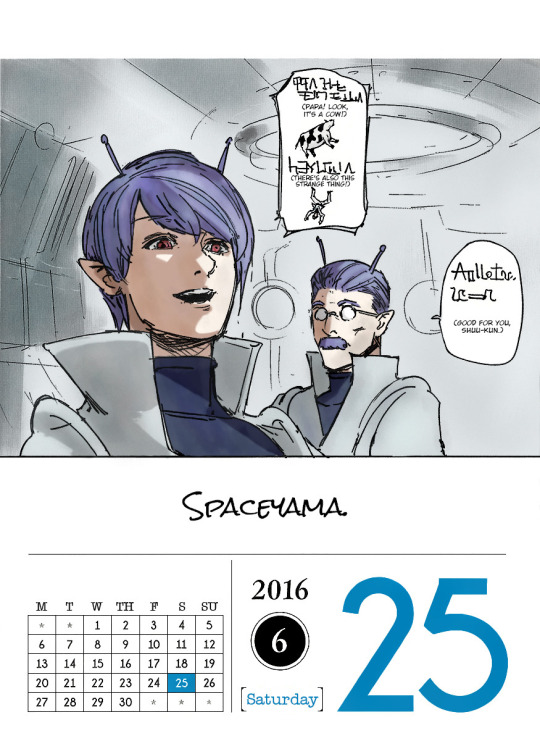
June 25th - Spaceyama.
No text. Shuu gets a cow and a Strange Thing and his father is proud.
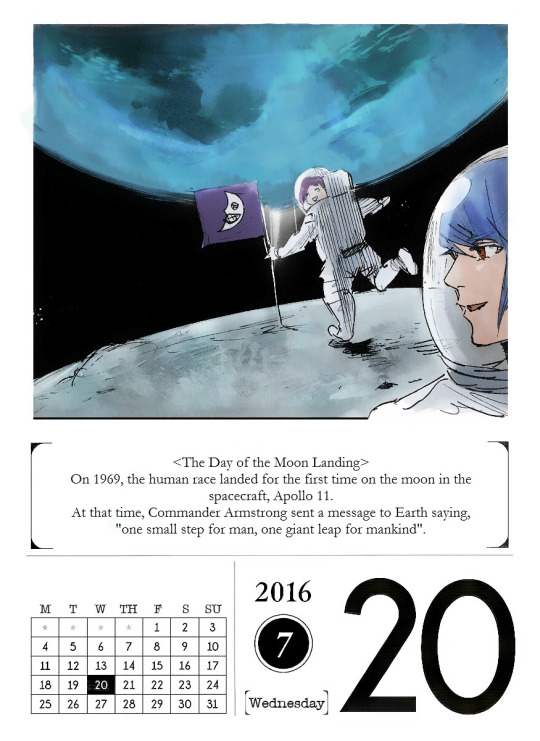
July 20th - The Day of the Moon Landing
On 1969, the human race landed for the first time on the moon in the spacecraft, Apollo 11. At that time, Commander Armstrong sent a message to Earth saying, “one small step for man, one giant leap for mankind”.
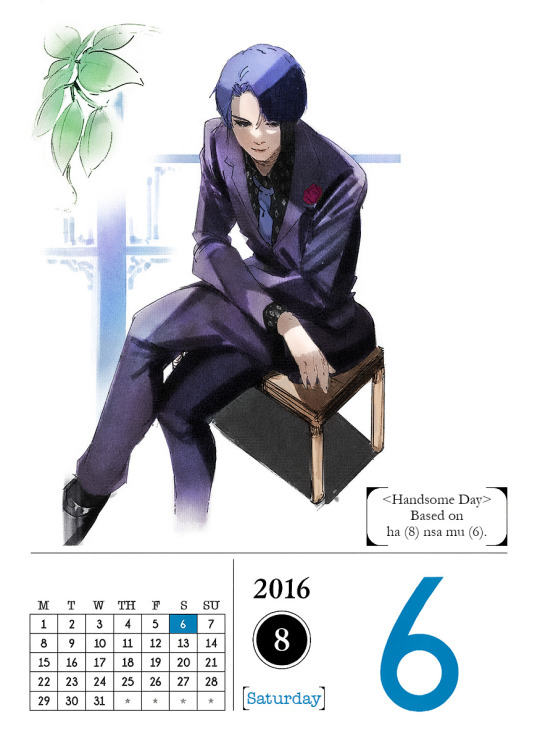
August 6th - Handsome Day
Based on ha (8) nsa mu (6).
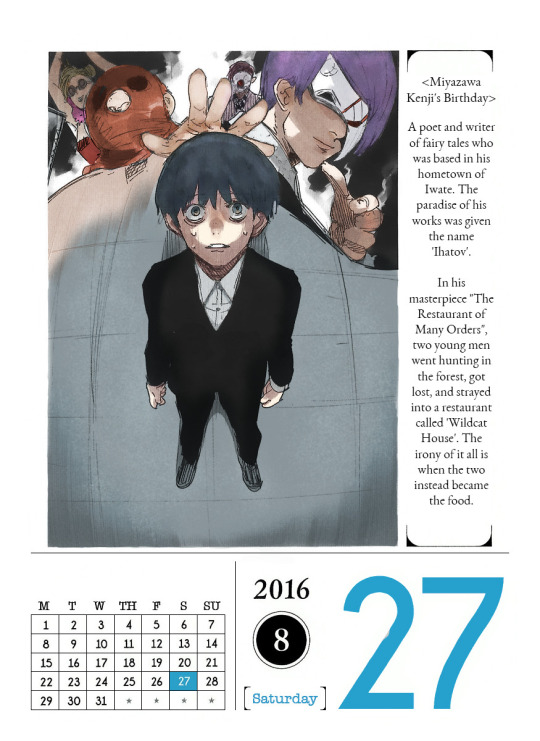
August 27th -Miyazawa Kenji’s Birthday
A poet and writer of fairy tales who was based in his hometown of Iwate. The paradise of his work was given the name ‘Ihatov’.
In his masterpiece “The Restaurant of Many Orders”, two young men went hunting in the forest, got lost, and strayed into a restaurant called ‘Wildcat House’. The irony of it all is when the two instead became the food.

September 21st - Fashion Show Day
On this day in 1927, the first fashion show in Japan took place in kimono shop called Mitsukoshi in Ginza. At that time, kimonos were mainstream.
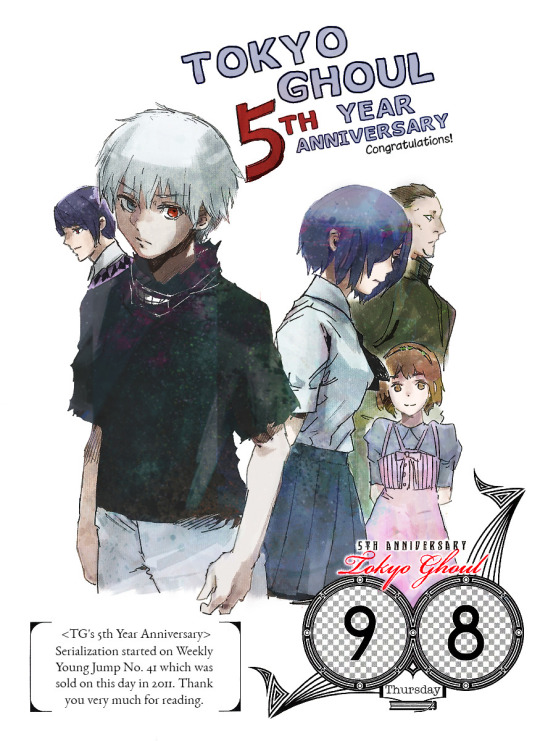
September 8th - TG’s 5th Year Anniversary
Serialization strted on Weekly Young Jump No. 41 which was sold on this day in 2011. Thank you very much for reading.
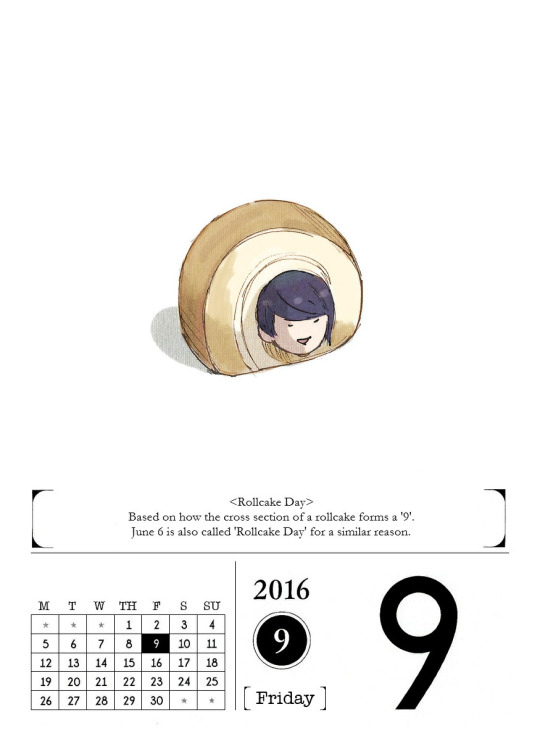
September 9th - Rollcake Day
Based on how the cross section of a rollcake forms a ‘9’. June 6th is also called ‘Rollcake Day’ for a similar reason.
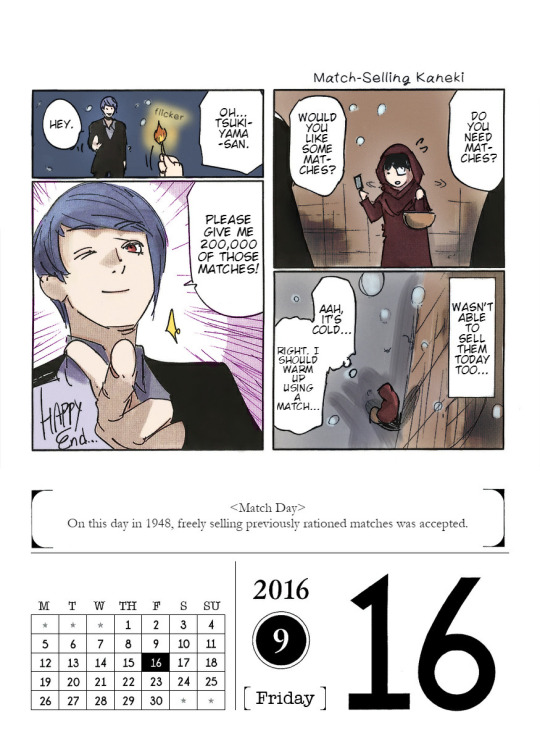
September 16th - Match Day
On this day in 1948, freely selling previously rationed matches was accepted.
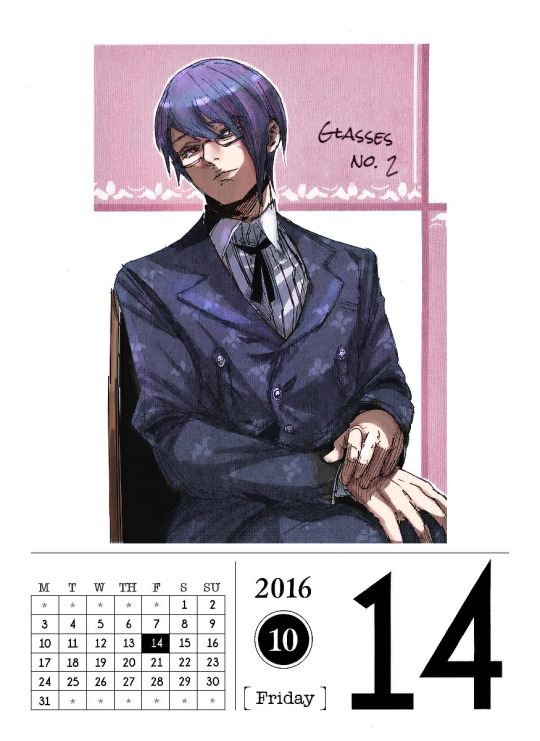
October 14th - Glasses No.2
No text.
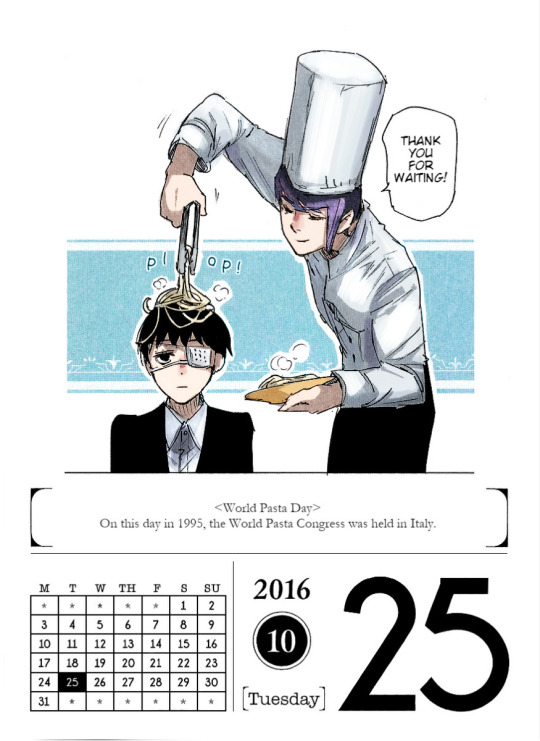
October 25th - World Pasta Day
On this day in 1995, the World Pasta Congress was held in Italy.
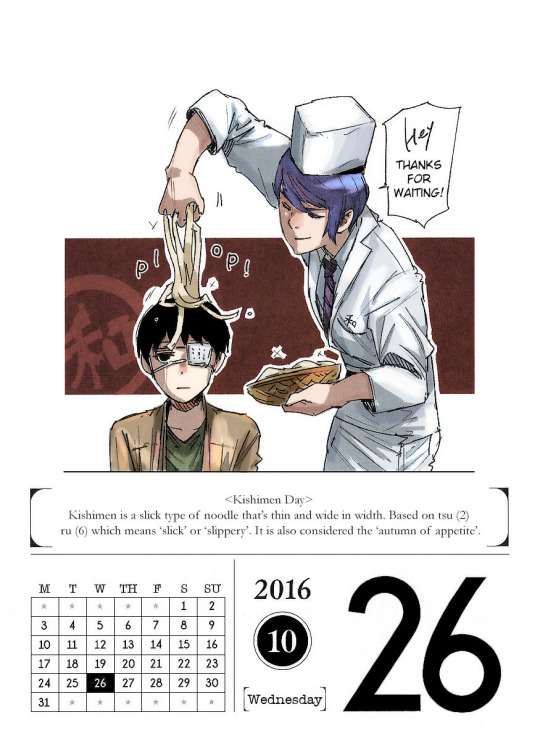
October 26th - Kishimen Day
Kishimen is a slick type of noodle that’s thin and wide in width. Based on tsu (2) ru (6) which means ‘slick’ or ‘slippery’. It is also considered the ‘autumn of appetite’.
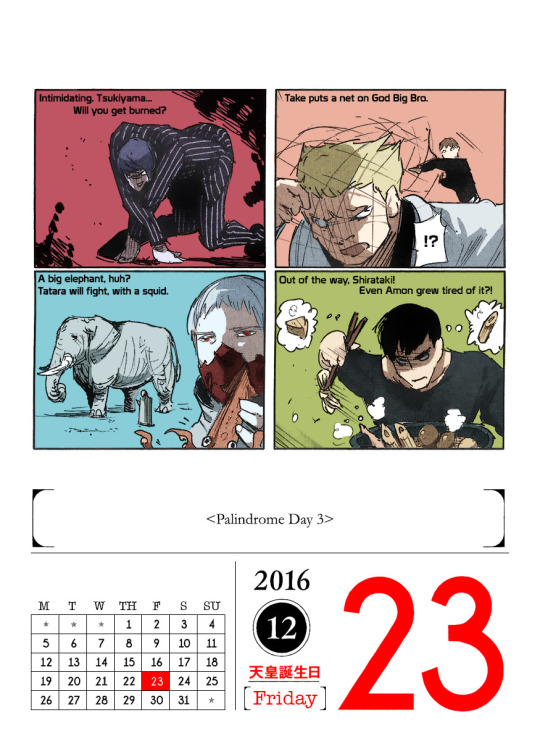
December 23rd - Palindrome Day 3
‘Intimidating, Tsukiyama… Will you get burned?’
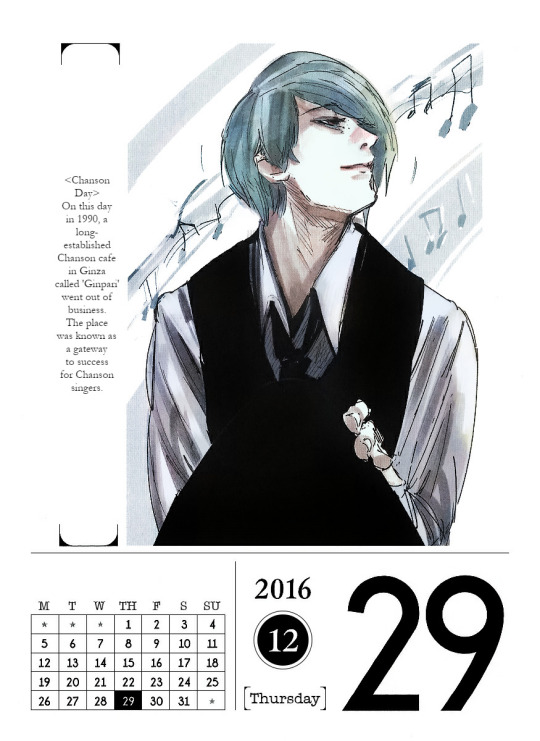
December 29th - Chanson Day
On this day in 1990, a long-established Chanson cafe in Gonzales called ‘Ginpan’ went out of business. The place was known as a gateway to success for Chanson singers.
Ok I think that’s all :)
Tell me if I have missed one, I will edit. Sorry, am tired from exam prep, hopefully this is okay. I love you so much. I feel like Shuu is always home for me in stressful times.
I’m planning to do one of these for Kanae and Rize too. I can do other characters I guess afterwards.
I own this calender. I think I might like a second one to cut out and make postcards with to go on my Shuu shrine.
#Goodness. I hope this is all correct#It took me so long#that second blog post always makes me sad :(#Bless you shuu#Thank you for being a part of my life#shuu tsukiyama#Tokyo ghoul#shuucore#gunk#tg gunk#tg calender
44 notes
·
View notes
Text

CUÁLES SON LAS DIFERENCIAS ENTRE NAVIDAD Y HANUKKAH? 🎄🕎 La Navidad y el Hanukkah son dos festividades profundamente arraigadas en tradiciones religiosas, pero con orígenes, símbolos y significados completamente distintos. Aunque ambas ocurren durante la temporada de invierno, sus historias y prácticas reflejan las ricas herencias del cristianismo y el judaísmo respectivamente. ¿Qué las hace tan únicas y especiales? Aquí te lo cuento. La Navidad, celebrada el 25 de diciembre, conmemora el nacimiento de Jesús de Nazaret, una figura central en el cristianismo. Sus orígenes se remontan a las tradiciones de la Iglesia primitiva, que buscó fijar una fecha para celebrar la llegada del “Salvador”. Aunque su significado principal es religioso, con el tiempo, la Navidad ha adquirido un carácter universal, mezclando elementos seculares como los árboles decorados, los regalos y la figura de Santa Claus. Esta festividad simboliza amor, esperanza y la unión familiar, y su celebración suele incluir misas, villancicos y banquetes festivos. Por otro lado, el Hanukkah, conocido como el Festival de las Luces, tiene un origen histórico que se sitúa en el siglo II a.C. en el contexto de la revuelta macabea. Los judíos, liderados por los Macabeos, se rebelaron contra el dominio helenístico para recuperar el control del Templo Sagrado en Jerusalén. Según la tradición, al purificar el templo, encontraron suficiente aceite para encender el candelabro durante un solo día, pero milagrosamente, las llamas permanecieron encendidas por ocho días. Este evento marcó el inicio de una festividad que celebra la resistencia, la fe y los milagros. La Navidad tiene un enfoque espiritual y familiar, pero también se ha comercializado significativamente. En contraste, el Hanukkah no es una de las festividades principales del judaísmo, pero ha ganado visibilidad en sociedades con mayoría cristiana, donde se celebra en paralelo a la Navidad. Durante Hanukkah, se encienden las velas de la menorá (un candelabro de nueve brazos) durante ocho noches, recordando el milagro del aceite. Además, se realizan juegos como el dreidel, se cantan canciones y se disfrutan alimentos fritos, como los latkes y los sufganiyot. Mientras la Navidad suele tener un enfoque en los regalos, el Hanukkah enfatiza la luz y la conexión espiritual. En términos de duración, la Navidad es una celebración de un día, aunque sus festividades se extienden durante la temporada navideña, mientras que el Hanukkah dura ocho días consecutivos, comenzando en el calendario judío el 25 de Kislev, lo que puede variar en fechas cada año en el calendario gregoriano. Aunque son festividades distintas, ambas comparten valores comunes: el deseo de reunir a las familias, reflexionar sobre la espiritualidad y transmitir mensajes de esperanza y perseverancia. En sociedades multiculturales, como en los Estados Unidos, estas celebraciones coexisten, enriqueciendo la diversidad y fomentando el entendimiento entre comunidades. Navidad y Hanukkah: dos caminos diferentes que iluminan el invierno con sus tradiciones, alegrías y significado profundo.
8 notes
·
View notes
Text
Women still lack visibility in Brazilian literature

Starting in 2026, the University Foundation for the Entrance Exam (Fuvest), which is responsible for selecting students for admission to the University of São Paulo (USP), will have a compulsory reading list with works written by women authors in Portuguese. The move comes in a bid to value the role of women in literature.
When the announcement was made last year, chair of the Fuvest Board of Curators and USP vice-President Maria Arminda do Nascimento Arruda justified the decision by saying that many of these writers “have for decades been made virtually invisible simply for being women.”
In the opinion of Lella Malta, founder and coordinator of Escreva, garota! (“Go ahead and write, girl!”), a support, engagement, and training collective for women who write, female invisibility in literature is still prevalent in Brazilian society. “The erasure of women’s writing is a phenomenon that still exists,” she said in an interview with Agência Brasil during the Pelourinho International Literary Festival—or Flipelô—in Salvador, Bahia.
“We may think it’s over, but you only have to look at the shelves to see that we still read more men. The publishing market events themselves promote this. And we women have this thing about self-sabotage; we think we’re never enough. I believe we have to work on these women, these future female authors, so they have courage and more self-esteem, and are able to reach this market in a more professional way. Writing is an instrument of female empowerment, and that’s our banner in the project,” she stated.
Continue reading.
#brazil#brazilian politics#politics#feminism#books#literature#image description in alt#mod nise da silveira
14 notes
·
View notes
Text
American R&B singer Aliaune Thiam, professionally known as Akon, has long wanted to help Senegal, the country he grew up in. He started Akon Lighting Africa in 2014 to install cheap Chinese solar-powered lighting systems across the continent. He hoped to do something more significant for Senegal. But how to fund it?
The answer turned out to be the same one adopted by a growing number of governments and entrepreneurs: a mixture of cryptocurrency and urban planning. It’s a combination that offers the promise of development without any of the tricky details—and which tends to turn out to be little more than vaporware. There was Bitcoin City in El Salvador, but also Painted Rock in Nevada, Satoshi Island in Vanuatu, Cryptoland in Fiji, or the Crypto-Kingdom of Bitcointopia in Utah.
In 2018, Akon announced a new cryptocurrency, to be called “akoin.” Akoin would enable Africans to, as the singer put it at a launch event, “advance themselves independent of the government”—in some manner. Most importantly, akoin would fund the creation of Akon City, an advanced planned city to be built in Senegal. Akon announced akoin and Akon City at the Cannes Lions Festival in June 2018. Akon said in November of that year that he had “everything planned out” for the city. But both Akon City and the akoin token remained only ideas for many months.
Akon was interested by the promises of cryptocurrency—specifically, free money by some unclear mechanism—but he was not up on the details of its technical or financial issues: “I come with the concepts and let the geeks figure it out,” he said. The akoin team featured initial coin offering (ICO) entrepreneurs such as Lynn Liss of ICO Impact and Crystal Rose Pierce.
The akoin cryptocurrency was pre-sold in a 2019 crypto token offering called “token of appreciation.” Each dollar “donation” would give you up to four tokens which would convert to akoin.
Akoin had not launched in Senegal at the time, despite billboards across the country. The West African CFA franc is the only legal currency in Senegal; BCEAO, the central bank, warned that akoin could not be used as a currency in the country.
Akoin promised all manner of functionality—special akoin wallet software, direct exchange with other cryptocurrencies or with cellphone minutes, an application marketplace, various “building blocks for entrepreneurship.” None of this was ever implemented.
Akoin finally started trading on a crypto exchange in November 2020. The akoin token didn’t do anything or have any particular utility; it was just a crypto token that you could trade. Pre-sale buyers dumped their akoin immediately and the price crashed. That’s not unusual: As of 2022, 24 percent of new cryptos fell 90 percent or more in their first week.
Akon posted on social media in January 2020 that he had “finalized the agreement for AKON CITY in Senegal”—though he had previously claimed that construction had already started in March 2019. The new city would be built near the small town of Mbodiène, about 100 kilometers south of the capital, Dakar.
Akon City would be a “smart city” inspired by the futuristic African nation of Wakanda from the 2018 movie Black Panther. The city would feature boldly curved skyscrapers, shopping malls, music and movie studios, “eco-friendly” tourist resorts, and a parking garage for flying cars.
Akon claimed in August 2020 that $2 billion of the $6 billion needed to build Akon City had been secured. He laid the foundation stone for the city on Aug. 31, 2020, and said that construction would start “next year,” in 2021.
Construction did not start in 2021, to the disappointment of locals. It was not clear where the $6 billion needed to build Akon City would come from. A representative for KE International, the United States-based contractor for Akon City, told AFP that more than $4 billion had been secured, with Kenyan entrepreneur Julius Mwale as lead investor, and that construction would start in October 2021—but it did not.
By 2022, Akon told the BBC that construction was “100,000 percent moving.” He said the COVID-19 pandemic was partly to blame for the delays. Akon was surprised at the “thousands of studies” that had to be done before work could even commence.
Senegal’s Society for the Development and Promotion of Coasts and Tourist Zones (SAPCO) had claimed the land by eminent domain in 2009 before offering it to Akon City in 2020. By 2023, no building work had been done at the Akon City site—though Axiome Construction insisted that geotechnical studies and environmental assessments were still under way. By this time, according to the Guardian, the only construction was a youth center nearby in Mbodiène, paid for personally by Akon—and built upon the foundation stone that he had laid in 2020.
Senegal finally lost patience with the project. Akon had missed several payments to SAPCO, and in June of this year, SAPCO sent a formal notice to Akon warning that work had to start by the end of July or SAPCO might take back almost all of the land grant.
Akon had already been looking for other opportunities to place akoin. In April 2021, he started talking to Uganda about setting up an Akon City there as well. In January 2022, the Ugandan government allocated him one square mile in Mpunge, in the Mukono district—despite objections from the National Unity Platform party and protests from Mpunge residents wanting compensation, which could not be paid before 2025.
Akon said that Akon City, Uganda, might be completed by 2036. At a 2021 news conference, he evaded questions on what the new city would cost or how it would be funded. The Forum for Democratic Change party said that the Ugandan Akon City would never happen and accused the government of granting “sweetheart deals” to developers.
Akon City was tech solutionism that leveraged the political power of celebrity. Akon wanted to launch a large project and thought that cryptocurrency, the buzzword of 2018, might fund his dream. He thought that this one weird trick would do the job.
In this case, the miracle technology was crypto. These days, such pushes by celebrities or entrepreneurs of new projects will typically use artificial intelligence—whatever that might mean in a particular case—as the marketing hook for a “smart city.
In his 2023 book Let Them Eat Crypto, Peter Howson of Northumbria University detailed how to head off solutionism-inspired blockchain projects that were heavy on publicity but light on the necessary bureaucratic work on the ground. His approach is broadly applicable to tech solutionism in general: Pay attention to the men behind the curtain. Howson has written recently on “smart city” plans as marketing for crypto tokens.
The Akon City plan was a worked example of speculative urbanization. A project is proposed with science-fiction concept drawings and a pitch aimed at tourists rather than locals; land is allocated; something might eventually be built, but it will bear little resemblance to the brochures. Christopher Marcinkoski of the University of Pennsylvania described Akon City as just one of many such initiatives, particularly in Africa, calling it “very much a real estate play.” The important output from such projects is local political capital—even as they never work out as advertised.
Cryptocurrency was an application of speculative urbanization to money—a high concept, a pitch to financial tourists, and the only end result being a token to speculate on and a tremendous amount of fraud. The Akon City project, however good Akon’s own intentions, seems functionally to have been merely the pitch for a crypto offering that failed—leaving an empty site, disappointed locals, and an embarrassed figurehead.
By 2024, akoin had been removed from the few crypto exchanges it had been listed on; it was effectively worthless. Akon sold short videos on Cameo—but he would not do requests related to cryptocurrency.
The speculative urbanization pitch rolls on. Actor Idris Elba has recently floated plans for an “environmentally friendly smart city” on Sherbro Island off Sierra Leone.
6 notes
·
View notes
Text

While he was in school, Bryce wished to join an after-school club. Given his hours of snowboarding the day before, the choice was a no-brainer. And speaking of snowboarding:

He had a wish to do more snowboard tricks, so after school and after signing up for the club, he headed back to the festival to do just that.

Also! Bryce's ex-babysitter Salvador did indeed age up. He's now the concessions vendor at the festival, so he and Bryce caught up a bit.
29 notes
·
View notes
Text

O Nordeste do Brasil é uma região vibrante e cheia de identidade, conhecida por sua cultura rica, paisagens deslumbrantes e hospitalidade única. Ao longo de seus 9 estados, o Nordeste reúne uma diversidade de tradições, história e belezas naturais que atraem turistas do mundo todo. Vamos conhecer mais sobre o que essa região tem a oferecer:
Estados do Nordeste:
1. Maranhão
2. Piauí
3. Ceará
4. Rio Grande do Norte
5. Paraíba
6. Pernambuco
7. Alagoas
8. Sergipe
9. Bahia
Principais Atrações:
• Praias: O litoral nordestino é famoso por suas praias paradisíacas, como Fernando de Noronha, Porto de Galinhas e Canoa Quebrada, que são verdadeiros paraísos para quem ama sol, mar e areia.
• Cultura: O Nordeste é o berço de ritmos musicais como o forró, o samba e o axé, além de ser um centro de manifestações culturais que fazem parte da alma do Brasil.
• História: A região foi onde os portugueses desembarcaram no Brasil, e, por isso, carrega um rico legado histórico. O Pelourinho, em Salvador, e o centro histórico de Olinda, em Pernambuco, são apenas alguns exemplos de lugares que preservam essa memória.
• Gastronomia: A comida nordestina é única e cheia de sabor, com pratos como carne de sol, feijoada, tacacá e acarajé, que refletem a mistura de influências indígenas, africanas e portuguesas.
• Carnaval: O Nordeste é famoso pelo seu carnaval vibrante, especialmente em Salvador e Olinda, onde as ruas se enchem de música, dança e alegria.
Cultura Nordestina:
• Música: O Nordeste é palco de muitos dos ritmos mais emblemáticos do Brasil, como o forró, o axé, o samba e o maracatu. Essas sonoridades podem ser ouvidas em festas, celebrações e até nas ruas durante o Carnaval.
• Dança: A dança também é uma parte importante da cultura nordestina, com ritmos como o coco, o frevo e o xaxado que acompanham a música em celebrações e festas populares.
• Arte: A arte nordestina é vibrante, expressa em pinturas, esculturas e artesanato, muitas vezes feitos com materiais típicos da região, como barro, palha e madeira.
• Literatura: O Nordeste tem uma rica tradição literária, com grandes autores como Jorge Amado, de Bahia, e Graciliano Ramos, de Alagoas, que retrataram a vida e os desafios da região em suas obras.
Economia:
• Agricultura: O Nordeste é um grande produtor agrícola, especialmente de frutas tropicais como manga, melão e coco, que são exportadas para diversos países.
• Turismo: A região atrai milhões de turistas todos os anos, especialmente para suas praias, festas culturais e centros históricos, movimentando a economia local.
• Indústria: Além da agricultura e do turismo, a região possui setores industriais importantes, como o têxtil, o alimentício e o de serviços, que contribuem para o crescimento econômico.
Curiosidades:
1. População: O Nordeste é a região mais populosa do Brasil, com grande concentração de pessoas em cidades como Salvador, Fortaleza e Recife.
2. Culinária Diversificada: A gastronomia nordestina é amplamente apreciada, tanto no Brasil quanto no exterior, sendo um dos maiores atrativos da região.
3. Eventos Culturais: O Nordeste é sede de alguns dos principais eventos culturais do país, como o Carnaval de Salvador, o Festival de Inverno de Garanhuns e a Festa de Iemanjá, na Bahia.
Conclusão:
O Nordeste é uma região fascinante que oferece belezas naturais, cultura vibrante e uma gastronomia deliciosa, além de ser um lugar onde as pessoas são acolhedoras e cheias de vida. Se você busca conhecer mais sobre o Brasil, essa é, sem dúvida, uma região que merece ser explorada.
5 notes
·
View notes
Text
Holidays 11.6
Holidays
All the Good Things Wrapped Up in One Day
Arbor Day (Republic of Congo, Samoa)
Bank Workers’ Day (Argentina)
Constitution Day (Dominican Republic, Tajikistan)
Electric Razor Day
Fala Day
Fill Our Staplers Day
Finnish Swedish Heritage Day
Flag Day (Chad, Finland)
Global Refill Day
Green March Day (Morocco, Western Sahara)
Gustavus Adolphus Day (Sweden)
Hydrogen Bomb First Test Day
International Day For Preventing the Exploitation of the Environment in War & Armed Conflict (UN)
International End Gossip Day
International Tracksuit Day
Legalization Day (Cannabis)
Malaria Day in the Americas
Marching Band Day
Marijuana Recreational Legalization Day (Colorado, Washington)
Marooned Without a Compass Day
Measure Up Day
National Basketball Day (a.k.a. Play Basketball Day)
National I Read Canadian Day (Canada)
National Ladies Learning Code Day (Canada)
National Michele Day
National Report Home Health Care Fraud Day
National Stacey Abrams Day
National Team Manager Day
Obama Day (Kenya)
Pine Nut Day (French Republic)
Recreational Cannabis Legalization Day (Colorado)
Saxophone Day
Scotchtoberfest (The Simpsons)
Skirret Day (French Republic)
Stranger Things Day
Tazaungdaing (Myanmar)
United Americas Day
World Cee-C Day (Nigeria)
World Lets Stop Shouting Awareness Day
World Materials Day
World Paper Free Day
Food & Drink Celebrations
Do Tater Tots Ever Grow Up? Day
Global Donut Day
National Nachos Day (a.k.a. I Love Nachos Day)
Peanut Butter Lovers Day
Independence & Related Days
Constitution Day (Tajikistan)
Cycoldia (Declared; 2018) [unrecognized]
Day of the First Shout For Independence (El Salvador)
Mexico (Independence Declared; 1813)
Polish Republic (Declared; 1918)
1st Wednesday in November
Eat Smart Day [1st Wednesday]
Hump Day [Every Wednesday]
International Pathology Day [1st Wednesday]
International Stress Awareness Day [1st Wednesday]
Men’s World Day [1st Wednesday]
National Advent Calendar Day [1st Wednesday]
National Eating Healthy Day [1st Wednesday]
National Holiday Calendar Day [1st Wednesday]
National Stress Awareness Day (UK) [1st Wednesday]
Take Our Kids to Work Day (Canada) [1st Wednesday]
Wacky Wednesday [Every Wednesday]
Website Wednesday [Every Wednesday]
Wheat Beer Wednesday [1st Wednesday of Each Month]
Wilderness Wednesday [1st Wednesday of Each Month]
Wobbly Wednesday [1st Wednesday]
Weekly Holidays beginning November 6 (1st Full Week of November)
None Known
Festivals Beginning November 6, 2024
Dublin Book Festival (Dublin, Ireland) [thru 11.10]
Hawai'i Food & Wine Festival (Oahu, Hawaii) [thru 11.10]
Jazz Fest Sarajevo (Sarajevo, Bosnia and Herzegovina) [thru 11.9]
Stockholm International Film Festival (Stockholm, Sweden) [thru 11.17]
Worlds of Flavor International Conference and Festival (Napa Valley, California) [thru 11.8]
Feast Days
Adelaide of Italy (Christian; Saint)
Albert Camus (Writerism)
Alois Senefelder (Artology)
Barlaam of Khutyn (Christian; Saint)
Birth of the Bab (Baha'i) [1 Muharram]
Birth of Tiamat (Ancient Egyptian mother of gods, goddess of primeval chaos)
Burroughs Day (Church of the SubGenius; Saint)
Cosimo de Medici the Elder (Positivist; Saint)
Dabucuri uiga, (Initiation Rites of the Young Men; to Jurupari, South American Guarani/Tupi God)
Demetrian (Christian; Saint)
Dodo Grieving Day (Pastafarian)
Feast of All Saints of Ireland (Ireland)
Festival of Total Submission
Herne’s Day II: Predator (Pagan)
Illtud (a.k.a. Illtyd or Iltntus; Christian; Saint)
Illitud’s Bell (Celtic Book of Days)
Learn a New Swear Word Day (Pastafarian)
Leonard of Noblac (Christian; Saint) [Coopers] *
Los Posadas (Latin America) [until 12.24]
Lucy Jones (Muppetism)
Melaine of Rennes (Christian; Saint)
Misa de Gallo begins (Rooster’s Mass; Philippines) [until 12.24]
Stephanie Vozzo (Artology)
Tiamat the Dragon Mother Day (Everyday Wicca)
Winds of Change Day (Starza Pagan Book of Days)
Winnoc (Christian; Saint)
Wish-Granting Championships (Fairies; Shamanism)
Lucky & Unlucky Days
Sakimake (先負 Japan) [Bad luck in the morning, good luck in the afternoon.]
Tycho Brahe Unlucky Day (Scandinavia) [33 of 37]
Uncyclopedia Bad to Be Born Today (because it’s National Day to Lose Money on Horses.)
Unglückstage (Unlucky Day; Pennsylvania Dutch) [26 of 30]
Unlucky Day (Grafton’s Manual of 1565) [51 of 60]
Premieres
All Along the Watchtower, recorded by Bob Dylan (Song; 1967)
And Then There Were None, by Agatha Christie (Mystery Novel; 1939) [29]
Behind Blue Eyes, by The Who (Song; 1971)
The Boondocks (Animated TV Series; 2005)
Chew Chew Baby or Stick to Your Gums (Rocky & Bullwinkle Cartoon, S4, Ep. 175; 1962)
A Cowboy Needs a Horse (Disney Cartoon; 1956)
Cry Freedom (Film; 1987)
Elizabeth (Film; 1998)
The Flea Circus (Tex Avery MGM Cartoon; 1954)
Forget-Me-Net, Parts 3 & 4 (Underdog Cartoon, S2, Eps. 31 & 32; 1965)
Foxtrot, by Genesis (Album; 1972)
Go Down Mooses or The Fall Guy (Rocky & Bullwinkle Cartoon, S2, Ep. 70; 1960)
Harry Potter and the Goblet of Fire (Film; 2005) [#4]
Head (Film; 1968)
Hiding Out (Film; 1987)
Hold What You’ve Got, by Joe Tex (Song; 1964)
Ickle Meets Pickle (Terrytoons Cartoon; 1942)
Jersey Boys (Broadway Musical; 2005)
John Wesley Harding, recorded by Bob Dylan (Song; 1967)
Justify My Love, by Madonna (Album; 1990)
Kitty Caddy (Phantasies Cartoon; 1947)
Less Than Zero (Film; 1987)
Little Good Beep (WB LT Cartoon; 2000)
The Little Match Girl (Color Rhapsody Cartoon; 1937)
Little Red Walking Hood (WB MM Cartoon; 1937)
Made in Heaven, by Queen (Album; 1995)
Meet the Press (TV Series; 1947)
The Missing Mountain or Peek-a-Boo Peak (Rocky & Bullwinkle Cartoon, S2, Ep. 69; 1960)
The Moon Fell in the River, by Guy Lombardo (Song; 1940)
Paper Doll, by The Mills Brothers (Song; 1943)
Passenger 57 (Film; 1992)
Pisces, Aquarius, Capricorn & Jones Ltd., by The Monks (Album; 1967)
Precious (Film; 2009)
Rain of Terror or The Desperate Showers (Rocky & Bullwinkle Cartoon, S4, Ep. 176; 1962)
The Robot Spy (Animated TV Show;Jonny Quest #8; 1964)
Secrets of Life (Short Documentary Film; 1956)
Ski-Napper (Chilly Willy Cartoon; 1964)
Sky Trooper (Disney Cartoon; 1942)
Spectre (UK Film; 2015) [James Bond #24]
Spotlight (Film; 2015)
Symphony No. 3 in A Minor, by Sergei Rachmaninoff (Symphony; 1936)
Time Bandits (Film; 1981)
24 (TV Series; 2001)
The Universe in a Nutshell, by Stephen Hawking (Book; 2001)
The Unpopular Mechanic (Oswald the Lucky Rabbit Cartoon; 1936)
An Unsuitable Job for a Woman, by P.D. James (Novel; 1972)
When We Were Very Young, by A.A.Milne (Children’s Book; 1924)
Wintertime Dreams, recorded by Woody Herman (Song; 1936)
Woody’s Kook-Out (Woody Woodpecker Cartoon; 1961)
Your Friend the Rat (Pixar Cartoon; 2007)
The Zoo (Oswald the Lucky Rabbit Cartoon; 1933)
Today’s Name Days
Christina, Leonhard, Rudolf (Austria)
Leonard, Melanija, Sever, Vedran (Croatia)
Liběna (Czech Republic)
Leonhardus (Denmark)
Aadi, Aado, Aadu, Ado, Adolf (Estonia)
Mimosa (Finland)
Bertille, Léonard (France)
Christine, Leonhard, Nina (Germany)
Leonardo (Greece)
Lénárd (Hungary)
Leonardo (Italy)
Leo, Leonards, Leonhards, Leons, Linards (Latvia)
Ašmantas, Leonardas, Vygaudė (Lithuania)
Lennart, Leonard (Norway)
Feliks, Leonard, Trzebowit, Ziemowit (Poland)
Pavel (Romania)
Renáta (Slovakia)
Alejandro, Leonardo, Severo (Spain)
Adolf, Gustav (Sweden)
Mac, Mack, Mackenzie, Makenzie, Mckenzie (USA)
Today is Also…
Day of Year: Day 311 of 2024; 55 days remaining in the year
ISO: Day 3 of Week 45 of 2024
Celtic Tree Calendar: Hagal (Hailstone) [Day 11 of 28]
Chinese: Month 10 (Yi-Hai), Day 6 (Jia-Xu)
Chinese Year of the: Dragon 4722 (until January 29, 2025) [Wu-Chen]
Hebrew: 5 Heshvan 5785
Islamic: 4 Jumada I 1446
J Cal: 11 Wood; Foursday [11 of 30]
Julian: 24 October 2024
Moon: 24%: Waxing Crescent
Positivist: 3 Frederic (12th Month) [Guicciardini / Philippe de Comines]
Runic Half Month: Wyn (Joy) [Day 15 of 15]
Season: Autumn or Fall (Day 45 of 90)
Week: 1st Full Week of November
Zodiac: Scorpio (Day 14 of 30)
2 notes
·
View notes
Text

Sessão de autógrafos de "Flor também - cinco contos e um romance": terça, 15 de outubro, às 20h, durante o II Flufsc - Festival Literário da UFSC.
Saiba mais: https://secarte.ufsc.br/event/ii-festival-literario-da-ufsc-flusc/
SINOPSE: Flor também (cinco contos e um romance) é uma antologia de textos ficcionais de diferentes naturezas, publicados antes em diferentes formatos e aqui reunidos pela primeira vez. Entre os contos estão desde narrativas curtas, como “Coração de galinha”, até uma breve novela, “Compra-se sonhos”. A capa traz uma foto tirada durante a Ocupação Coaty, quando os sonhos deste conto foram projetados nas paredes do Coaty, prédio desenhado por Lina Bo Bardi e instalado na Ladeira da Misericórdia, em Salvador. Já o romance “Viagens de Walter”, escrito em 2013 e reescrito em 2024, se passa em Salvador, Recife e Florianópolis e conta a jornada de superação de traumas vivida por um jovem médico. Com orelha de Luci Collin, este livro vem recomendado também por Sérgio Tavares, Elisa Tonon, Alcides Buss e Patrícia Claudine Hoffmann. É o oitavo livro de Katherine Funke, escritora nascida em Joinville, também jornalista, editora e doutora em Literatura.
Link para comprar na loja da editora
2 notes
·
View notes
Text










¿Qué hace que una fotografía sea genial? ¿Hasta qué punto una instantánea se considera buena solo porque su autor es conocido? La pregunta sobrevuela estos días en el Casino de Cadaqués, donde piezas de The Anonymous Project, la impresionante colección de fotografías amateur del cineasta Lee Shulman (Londres, 1973), se enfrentan a las del fotógrafo de Magnum Martin Parr (Epsom, 1952). Averiguar a qué archivo pertenecen unas y otras es el desafío al que se enfrenta el espectador de Déjà View , exposición que parte del libro homónimo publicado por la editorial Textuel y que ahora forma parte del Festival Internacional de Fotografía InCadaqués.
Deja View es la alegre colaboración con el formidable Martin Parr @martinparrstudio que ahora se presenta en el festival @incadaques_festival a partir de hoy. Un divertido juego de emparejar imágenes de archivo con uno de los fotógrafos británicos más importantes. Surge la pregunta ¿Qué hace que una imagen sea excelente? Esta es una parte de las nuevas obras que también se muestran en este impresionante lugar. Cadaqués fue la ciudad natal de Salvador Dalí y todavía inspira a muchos artistas jóvenes. Durante las próximas dos semanas se celebrarán muchos espectáculos fabulosos. El libro ha sido reimpreso y ya está disponible en @editions_textuel diseño @agnesdahanstudio
#theanonymousproject#anonymousphotoproject#leeshulman#family#35mm#photography#photooftheday#art#kodachrome#martin parr#cadaques#incadaques festival
2 notes
·
View notes
Text
Reflections on a Year of Reading Brazilian Literature 🇧🇷
Books Read This Year; Backlands: The Canudos Campaign by Euclides da Cunha, Macunaíma: The Hero With No Character by Mario de Andrade, Hippie by Paulo Coelho and Captains of the Sands by Jorge Amado
All throughout the year, my piece of Brazilian literature mostly focused on the northeastern part of Brazil. In Backlands, I explored the northeastern part of Brazil. With its dry, arid and empty lands, I learned of the mountains and sertões surrounding areas like the Bahia, Alagoas, Pernambuco, Ceara, Piauí and Maranhão. During the summer, the sertão is known for being so dry that even rain is impossible to get. Macunaíma mostly takes place in Brazil's beautiful, lush and dense rainforests with its main character, Macunaíma growing up and living there. Before he became the Hero With No Character, he was thrown away by his mother in a spacious clearing within the beautiful forest. Captains of the Sands takes place in the Bahia, specifically the capital, Salvador. Based on the fact that the Captains lived on a warehouse along the docks of Salvador, I learned that it was somewhat of a coastal city, with beautiful beaches and a lot of vendors surrounding it.
While reading these books, I learned a good amount of Brazilian history. For example, In Backlands, I learned about Antonio Conselheiro, a rebel that led one of the bloodiest uprisings in Brazil. Before this, his family was known as a dangerous family, killing several rich people and pillaging their fortunes. Conselheiro changed that when he decided to become a leader and try to help the northeast be free of southern rule. Macunaíma, however is slightly different. It is neither fully history nor truth, rather a mixture of both. Since almost all of the characters in the book are fake, the events that happen throughout the book are real and always tie in with Macunaíma and his brothers' escapades. Hippie takes place in the 70s and the 70s was a strange time for the world. While reading that book, I learned more about the hippie movement, especially about magic buses, buses that would travel entire continents to get their inebriated passengers to spiritual places like Nepal, for instance. Coelho and his new friend travel from Amsterdam to Kathmandu and on the way, they stop in Constantinople which is now know as Istanbul. I also learned that many. "hippies" were not dedicated to the lifestyle. They merely saw it as a trend and rolled on with the times. Many gave up and returned home to get real jobs and start families after they were done "exploring."
Brazil's culture is very rich and while Hippie doesn't strictly talk about it, Macunaíma does. Many of the adventures Macunaíma and his brothers go on inadvertently cause some shift in Brazilian culture. When Macunaíma first met Ci, the amazon queen of the forest and married her, she later on died and became a star and gave Macunaíma a talisman that was then taken from him and he embarks on a journey to find it. Later on in the book, Macunaíma travels to São Paulo where he attends a festival and talks about the Cruzeiro do Sul and how it is a god, not just a cluster of stars. Mainly, the first few chapters take many things from indigenous culture in Brazil. For example, the author, Mario De Andrade made Macunaíma's catchphrase, "Aí, que preguiça!" which is a fusion of Portuguese and the Tupi language. "Aí," means sloth in Tupi, whereas "preguiça" is the Portuguese word for sloth. This book was also published during Brazil's famous modernism movement. Some say it was one of the founding pieces of literature for the movement. It was published six years after the "Semana de Arte Moderna," and symbolized the beginning of the movement.
From Backlands: The Canudos Campaign, I learned that despite facing difficult odds, in life you must over come that adversity and keep moving on. While reading Macunaíma: The Hero With No Character, I learned that in life, your identity is fluid and it can change many times, so don't try to suppress or change it. In Hippie, I learned that in order to live life, you must embrace the unknown and challenge yourself. Take risks and learn before its too late. Finally, I Captains of the Sands, I learned that I should not let my circumstances dictate who I am or what I am going to be. In life, there will be people who put pressure and doubt your abilities because of where you are from and you shouldn't let that shake your worth.
Some things I learned about myself while reading these books is that I love Brazilian literature. It is incredibly abstract and different than English or American literature. Although some literary works may be difficult to comprehend (mostly because of translation), I think that reading books from a different country can change your previous perspective on a country, it sure changed mine. It made me want to learn more about Brazil and ignited a new flame for Brazilian literature. While I am not done with Captains of the Sands, I will continue to read it because its a well-written book full of humor and societal commentary. This is my OFFICIAL final blog post. Acabou, and muito obrigado. victoriasbrazilianlitblog, out!
Word count: 834
#hippie#brazilian literature#paulocoelho#macunaima#mariodeandrade#jorge amado#brazil#captainsofthesands#bahia
3 notes
·
View notes
Text
Blog 1
For a long time, I always said I wasn’t creative. In my mind, creativity meant being vulnerable, and I was afraid to be seen. I had a heavy appreciation for the creativity of others. I spent my childhood with a book in hand constantly, and I loved googling different artists (did anyone else go through the Rene Magritte/Salvador Dali phase at 13?), as well as going to street festivals to look at the jewelry people made by hand. I would go home and write about the things I saw, write about my experiences, and keep all my “notebooks” (because I couldn’t call them journals) as secret as possible, standing by my idea that I was logical, and smart, but absolutely not creative. I was convinced I was not blessed with that specific gift as my sisters were, not realizing until much later in life that often creativity is a practice, not something a person is just given.
Meanwhile, there I was most of my life practicing the creativity of writing and just never letting anyone see it. I carried my notebooks around from move to move, apartment to house, over and over like I was afraid to lose that part of me. Two years ago, I made the decision to start letting go of the past. To start that process, I re-read each notebook, took notes on it for my therapy sessions, and with each one finished I burned them in a barrel in the backyard. At the time it did feel quite therapeutic, if not dramatic. My notes outlined how early my anxiety could be seen manifesting, when my depression started, my struggle with religion at a young age, negativity, and much deeper emotions as the years went on. I was forced to look in the face of life events that I had decided to bury deep down. Therapy was starting to make more sense. All the times before my dear therapist, who I will call “Rebecca,” would say “feel your feelings, sit with your feelings” I couldn’t comprehend how to do that. Doing this practice made it start to click, though I still struggle and have to make myself really stop and feel, as miserable as it might be. No one said therapy was an easy process!
At this time, I was going through some major life decisions. Not only was I dredging up my past in my therapy sessions on a weekly basis, but I was also debating with myself on leaving my career, and I had just transitioned out of the Air Force Reserves. I was trying to find a hobby, as well as wondering what I could do with my future if I wasn’t tied to the job I had chosen that sucked up all of my energy, time, and compassion. I thought maybe I should try something I haven’t done before. Something creative? I attempted to try to start a blog, as well as took up a noncredit photography class online through a local college. Both of those things I felt terribly unskilled with, and one of my domineering personality traits is I HATE to be bad at something. So, I didn’t continue, but kept saying out loud when people would ask: “I’m going to start a blog! I got a camera and am going to start taking photos!” There was some hope, albeit a small amount. I figured maybe the more I said it, the more I would convince myself to just start already. All these people already knew what my intentions were! I told myself over and over to let myself be bad at it, practice more, and maybe I’ll eventually get better. That was a year and a half ago, all the way up until now. These things take time, right?
Part of my struggle to commit was a theme. Every blog I’ve come across has been a niche that I didn’t feel connected to, or convinced me the market is saturated and what quality do I possibly have to contribute to this? There are 600 million blogs currently. I kept a running list in the Notes app on my phone of what I was interested in writing about: women in the military, travel, books, my 30’s, women’s safety, being child-free, books, post-DD214 life. All of which has been done before! But it’s taken me this long to remind myself I don’t write to provide never-before-seen content. I write to feel my feelings! To share opinions, and celebrate the small joys in life, to make a written history of things I may not even remember in 15 years. And I think finally, 10 months after making the active decision to leave my job, and a year after I purchased a travel trailer and committed to an alternative lifestyle, I finally realized that I can write about things that have been written about before. I can take photos of trees and birds and be bad at it for a while. I can grant myself grace in trying something new and being vulnerable.
Cheers to myself for taking the first step, even if it was a very looooong step. I’m not going to be an influencer, or content creator, or make money. But I am going to write and attempt to share my musings, and hope others can take that step as well. You don’t have to be naturally talented to try something new, and no one is an expert their first time.

Photo taken at Todd Nature Reserve in Pennsylvania, October 2022
2 notes
·
View notes
Note
if you go that route, have you thought about how their (salvadore and daeran's) wedding would be?
I did and I thought about their wedding a lot. 🥰 They both are men of big gestures and known to leave a strong impression with anything they do, although in slightly different ways. Salvadore wouldn’t admit it, but he always had very specific ideas regarding his wedding for someone who never truly had planned to get married (unless for political reasons should it come to it) at all. Daeran would have preferred something unconventional, a huge festivity too, but with some kind of provoking, maybe even shocking element to it. But a classical, very big, and serious wedding – a true ceremony – was so important to Salvadore that Daeran agreed to it. (In the end, secretly overwhelmed by it in the best imaginable, most emotional of ways. After all, he highly enjoys huge romantic scenarios too.) The planning took months, the guest list alone was a challenge already, especially since the wedding happened during the time of political turmoil in Mendev after queen Galfrey’s death. (Salvadore also used it to further solidify his claim to the throne.) Their wedding suits were custom-made, of course, and the best tailors of Drezen, Nerosyan, and Absalom competed for the commission. Eventually, they decided on very elegant garments in white and golden. – The color scheme for all the decorations too. The wedding itself took place in the Cruciform Cathedral in Nerosyan. Both Salvadore and Daeran are atheists, but Salvadore’s opinion of Iomedae grew much more positive after she had started not only to accept but to support him in his decision to keep his angelic powers and to treat him like the Celestial he had become. To choose her Cathedral for the wedding suited his and Iomedae’s … Salvadore would call it an alliance. (Furthermore, it fitted the aesthetic he had in mind.) The ceremony was solemn and extravagant, the room filled with a vast number of white flowers and elegant golden adornments, flooded by sunlight, and a string quartet accentuated their arrival. Since Daeran had agreed to leave this part of the planning mainly to Salvadore, in return he got to decide all the details about the celebrations afterwards and was allowed to bring on any debauchery he wished for. It became an illustrious party in and around their estate in Nerosyan. Daeran ordered delicacies from different countries, an impressive variety of wines, liquors and other substances, hired renowned musicians, artists, dancers and performers, and of course they had fireworks. The festivities went on for three days and afterwards Salvadore and Daeran left for their honeymoon on the Isle of Kortos / in Absalom. Thank you so much for the ask, anon! 💕 I love to talk about their wedding.
#pathfinder wotr#daeran x commander#knight and dae#commander x daeran#knight commander salvadore#oc: salvadore#my ocs#dmagedtexts#anon#dmagedanswers
17 notes
·
View notes